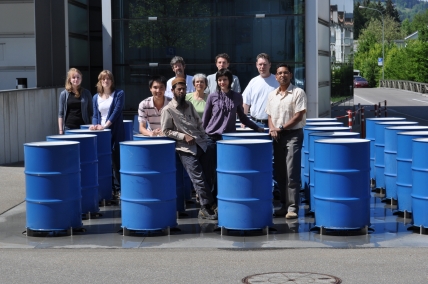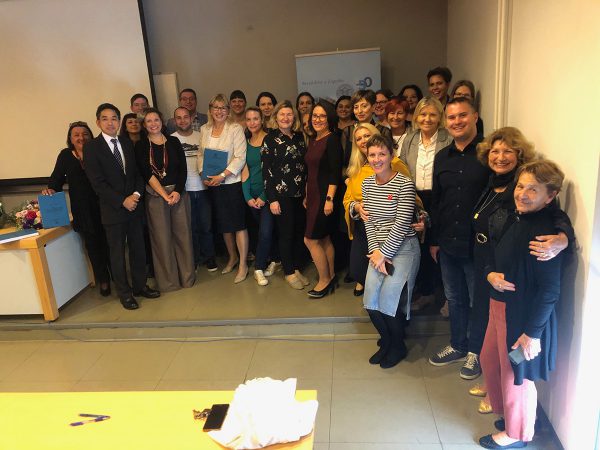Title: Antimicrobial functionalisation of PLA polymer
Main applicant: Marina Turalija, PhD student, assistant, University of
Zagreb Faculty of Textile Technology
Co-applicant: Sabyasachi Gaan, PhD, EMPA, Swiss Federal
Laboratories for Materials Science and Technology
![]()
Introduction
Main research objective is to obtain antimicrobial functionality of biodegradable and sustainable PLA films or membranes, enabling their usage for food packaging or medical purposes. The objective would be accomplished by several modifications, either the bulk modification or the surface one, enabling interdisciplinarity within biomedical (antimicrobial agents) and food sector (PLA membrane for the packaging).
Polylactide acid (PLA) is thermoplastic aliphatic polyester and currently finds use in diverse areas such as biomedical applications, textiles, composite and food packaging. It is one of the most studied polymers of this family because it can be produced via fermentation of renewable resources, like sugar, beets or corn starch.
In this research we will carry out surface and bulk modification of PLA to achieve antimicrobial functionality.
The novelty of this research consisting of surface modification with different antimicrobial agents is in the application on the biodegradable and sustainable PLA polymers. Part of the modification would be done with silver, either as pure silver deposit or as silver nano-composite. Bulk modification of PLA was done with addition of Sanitized®BC A 21-61.
Films and membranes produced from biodegradable PLA present great novelty and they will be additionally improved by antimicrobial processing. Antimicrobial substances incorporated into the packaging materials can control microbial contamination extending the lag-phase of the target microorganism, or by reducing the growth rate and maximum growth population or by inactivating microorganisms by contact. Characteristics of antimicrobial substances and foods components significantly affect the effectiveness of the antimicrobial substances and their release.
Objectives, significance and contributed added value of the visit
EMPA is an interdisciplinary research and services institution for material sciences and technology development within the ETH Domain. As independent federal research institution, EMPA solves selected tasks and problems of scientific and technical nature, and it employs more than 800 people. (www.empa.ch). EMPA is dedicated to working towards achieving sustainable solutions to the high priority challenges facing society, science and industry in the field of material science and technology by means of its strategically and programmatically oriented research and development efforts. The aim of EMPA activities is to transform research results and scientific knowledge into marketable innovations. In taking on this bridging function between applications oriented research and the practical implementation of novel ideas, EMPA contributes significantly to improving the competitive capability of the Swiss economy and to enhancing the quality of life of humanity.
In its role as a research institution within the ETH Domain, EMPA is committed to achieving excellence in its research activities and thereby holds an essential position in the Swiss educational, research and innovation scene.
With its research experience EMPA can offer its industrial partners solutions tailored to meet their specific needs. This encourages companies to think and act in innovative ways and at the same time helps to improve the quality of life for all of us. Safety, reliability and sustainability of materials and systems – these are the watchwords which form a common thread running through all EMPA activities. In this respect the institution plays a key role in the Swiss educational, research and innovation scene.
Laboratory for Biomaterials: The research of this laboratory focuses on the development of biomaterials and biomolecules for medical and industrially interesting applications, as well as services in biotechnology and bioanalytics. Their research includes the fermentation of microorganisms, as well as the expression of specific enzymes in bacteria for purification and application in catalysis of chemical reactions. For the development if materials made from biomass, commercial products and own synthesized polymers are applied, which are modified in innovative ways to obtain the desired material properties applicable in the fields of packaging, agriculture, coatings, medical and clothing.
Laboratory of Advanced Fibers: The research of this laboratory focuses on the development of advanced synthetic fibers using new combinations of materials to achieve improved or novel properties. Therefore, they make use of their pilot melt spinning plant or other spinning techniques. The resulting multi-component or (nano-) composite fibers are produced in quantities that allow industrial testing and prototyping. The fibers’ geometrical shape can be modified during spinning; alternatively, microstructures can be imprinted onto the fiber surface in post-processing. Also, low pressure plasma technology is used to modify fiber and textile surfaces. Processes like activation, cleaning, cross-linking, plasmapolymerization, plasma-metallization and combinations thereof can be far better controlled in low pressure plasmas.
The group of Additives & Chemisty is working on the following topics: Synthesis of novel chemical compounds for additives, polymers or coatings, which bestow new properties upon synthetic fibers or textiles. Properties of particular interest include flame retardance, UV protection, photocatalysis, crystallization during spinning or the release of substances. Operation and development of high-standard chemical and instrumental analytics as used in their research activities and for external bodies from industry or public authorities. During the research secondment in EMPA – St. Gallen, in group of Additives & Chemisty, supervisor of PhD student Marina Turalija is Dr. Sabyasachi Gann.

Figure 1.The group of Additives & Chemisty, Laboratory of Advanced Fibers, EMPA Swiss Federal Laboratories for Materials Science and Technology
Expected measurable results of the visit
Project is interdisciplinary requiring excellent knowledge of chemistry, microbiology and ecology. One of the great challenges is to implement developed biodegradable PLA films with additional antimicrobial effectiveness into the food industry where its possible usage is predicted. Biodegradable films of membranes developed within the project will be composed of PLA polymer modified by different nanoparticles.
Joint research initiatives, performed on both institutions, will be dedicated to development of innovative textile or related product – contributing in this way to the industrial needs of both involved countries. One of the specific goals of the scientific collaboration is to share mentorship of the PhD thesis of the candidate Marina Turalija. Already signed cooperation contract served as formal establishment of cooperation between the both parties involved.
Relevance and potential benefit of the project to the development of Croatia
Potential benefits of the project to the development of Croatia are: 1) Expertise in production of films and membranes which can be transferred to Croatian SMEs. 2) Specialisation in surface and bulk modifications PLA polymer 3) Capability of independent antimicrobial testing which will be extremely useful for the cooperation with University of Medicine Zagreb, whose microbiological laboratories are on the disposal to Faculty of Textile Technology. 4) Upgrading of skills on SEM will be logical extension of basic training performed at Faculty of Textile Technology which has recently purchased FE-SEM.
Results:
Antimicrobial activity of PLA films were measured against two Gram-positive bacteria Listeria monocytogenes (DMSZ15675) and Staphylococcus aureus (ATCC6538) and two Gram-negative bacteria Salmonella typhimurium (TA100) and Escherichia coli (DSMZ30083). A protocol based on the ISO 22196 : 2007, standard for measurement of antibacterial activity on plastics has been defined.
PLA was modified with glycerol, polyethylene glycol and chitosan to achieve hydrophilic PLA surfaces. Addition of glycerol, polyethylene glycol and chitosan significantly reduced the contact angle (CA measurement) of PLA from 70° (for unmodified PLA) to 40° (modified PLA).
Surface modifications with silver, either as pure silver deposit or as silver nano-composite, also improve hydrophilic PLA surfaces to 25° (modified PLA).
To effectively inhibit microorganism growth, the antimicrobial agent must interrupt the growth cycle.The four tested bacteria, applied in the study, showed different sensitivity to the silver modified PLA surfaces: Escherichia coli was very sensitive > 6 log reduction whereas Staphylococcus aureus was tolerant > 2 log reduction.
Silver is a well recognized antimicrobial agent and bulk or surface modifications with silver, either as pure silver deposit or as silver nano-composite, significantly improve the antimicrobial properties of PLA films. The modified PLA films were particularly efficient against Escherichia coli, Staphylococcus aureus, Listeria monocytogenes and Salmonella typhimurium bacterias and they might find their future application in biomedical and food packaging areas.
Films which were treated simultaneously by plasma polymerization/sputtering technique (Ag nano-composite thin films) exhibited better effectiveness against used bacterias, than the pure silver deposit. Surface topography and size/distribution of Ag nanoparticles were found to influence the Ag ion release kinetics. Therefore, the release of silver from the surfaces was significantly higher in the case of samples with Ag nano-composite thin films.
The project was supported by:
|
|
|
|
|
|
|
|
|
![]()







